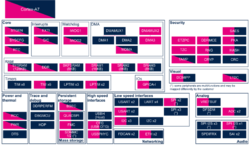1 Article purpose[edit source]
The purpose of this article is to
- briefly introduce the VREFBUF peripheral and its main features
- indicate the level of security supported by this hardware block
- explain how each instance can be allocated to the runtime contexts and linked to the corresponding software components
- explain, when needed, how to configure the VREFBUF peripheral.
2 Peripheral overview[edit source]
The VREFBUF peripheral is an internal voltage regulator.
2.1 Features[edit source]
The VREFBUF is supplied via the VDDA pin. When enabled, it can provide a reference voltage in the range of: 1,65V, 1,8V, 2,048V or 2,5V. The VREFBUF can be used to provide an analog voltage reference for:
- ADC internal peripheral[1]
- External components through the dedicated VREF+ pin.
The VREFBUF can be left unused. In this case, an external voltage regulator can provide reference voltage to VREF+ pin.
Refer to the STM32MP13 reference manuals for the complete list of features, and to the software components, introduced below, to know which features are really implemented.
2.2 Security support[edit source]
The VREFBUF is a secure peripheral (under ETZPC control).
3 Peripheral usage and associated software[edit source]
3.1 Boot time[edit source]
The VREFBUF is usually not used at boot time. But it may be needed by the SSBL (see Boot chain overview), to supply the internal ADC[1] for example.
3.2 Runtime[edit source]
3.2.1 Overview[edit source]
The VREFBUF can be allocated to:
- The Arm® Cortex®-A7 secure to be used under OP-TEE SCMI regulator framework</ref>.
or
- The Arm® Cortex®-A7 non-secure to be used under Linux® with regulator framework[2].
The Peripheral assignment chapter describes which peripheral instance can be assigned to which context.
3.2.2 Software frameworks[edit source]
| Domain | Peripheral | Software components | Comment | |
|---|---|---|---|---|
| OP-TEE | Linux | |||
| Analog | VREFBUF | OP-TEE SCMI | Linux regulator framework | |
3.2.3 Peripheral configuration[edit source]
The configuration is applied by the firmware running in the context to which the peripheral is assigned. The configuration by itself can be performed via the STM32CubeMX tool for all internal peripherals. It can then be manually completed (especially for external peripherals) according to the information given in the corresponding software framework article.
- For the Linux kernel configuration, please refer to device internal regulator. An example can be found also in ADC DT configuration examples
- In case the control of VREFBUF consumers are spread across the various cores, see also Resource manager for coprocessing
3.2.4 Peripheral assignment[edit source]
Click on the right to expand the legend...
Check boxes illustrate the possible peripheral allocations supported by STM32 MPU Embedded Software:
- ☐ means that the peripheral can be assigned (☑) to the given runtime context.
- ⬚ means that the peripheral can be assigned to the given runtime context, but this configuration is not supported in STM32 MPU Embedded Software distribution.
- ✓ is used for system peripherals that cannot be unchecked because they are statically connected in the device.
Refer to How to assign an internal peripheral to an execution context for more information on how to assign peripherals manually or via STM32CubeMX.
The present chapter describes STMicroelectronics recommendations or choice of implementation. Additional possiblities might be described in STM32MP13 reference manuals.
| Domain | Peripheral | Runtime allocation | Comment | ||
|---|---|---|---|---|---|
| Instance | Cortex-A7 secure (OP-TEE) |
Cortex-A7 non-secure (Linux) | |||
| Analog | VREFBUF | VREFBUF | ☐ | ☐ | Assignment (single choice) VREFBUF should be secured whenever one ADC is secured. VREFBUF must not be secured when all ADC are non-secured. |
4 References[edit source]
- ↑ 1.0 1.1 ADC internal peripheral
- ↑ Regulator overview, Linux® regulator framework overview
